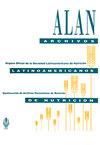Relationship of vitamin D intake and sun exposure with serum 25-hydroxyvitamin-D in schoolchildren with obesity
IF 0.5
4区 医学
Q4 NUTRITION & DIETETICS
引用次数: 0
Abstract
The obesity worldwide has produced an increase in obesity-related diseases and can be associated with low concentrations of 25-hydroxyvitamin-D. Also obesity and low physical activity can decrease sun exposure, so the aim was to correlate vitamin D intake with serum 25-hydroxyvitamin-D levels and to assess sun exposure habits in schoolchildren with obesity. Materials and methods. A correlational study was performed from January 2017 to January 2018 on 103 children between 6-12 years of age, with a body mass index ≥+2SD for age and sex, according to the World Health Organization. Blood samples were taken to determine the serum concentrations of 25-hydroxyvitamin-D, a nutritional survey to determine the vitamin D intake and a sun exposure questionnaire were applied. A Spearman correlation coefficient analysis was performed. Results. Forty-seven percent of the children were girls. The median years of age was 10. The median serum 25-hydroxyvitamin-D levels were 35.5 ng/mL, 74.8% had sufficient levels, 25.2% had insufficient levels. The median vitamin D intake was 214.7IU in boys and 231.9IU in girls. Regarding sun exposure, most of the children had excessive levels of sun exposure and inadequate sun protection practices. A positive correlation between vitamin D intake and serum 25-hydroxyvitamin-D was identified only in boys (rho=0.276, p=0.041). Conclusion. A positive correlation between vitamin D intake and serum 25-hydroxyvitamin-D levels was found in obese boys and excessive levels of sun exposure with inadequate sun protection practices in boys and girls.肥胖学龄儿童维生素D摄入量和日晒与血清25-羟基维生素D的关系
世界范围内的肥胖导致了肥胖相关疾病的增加,这可能与25-羟基维生素d浓度低有关。此外,肥胖和低体力活动也会减少阳光照射,因此目的是将维生素D摄入量与血清25-羟基维生素D水平联系起来,并评估肥胖学龄儿童的阳光照射习惯。材料和方法。根据世界卫生组织的数据,2017年1月至2018年1月,对103名年龄和性别体重指数≥+2SD的6-12岁儿童进行了一项相关研究。采集血样测定血清25-羟基维生素D浓度,进行营养调查测定维生素D摄入量,并进行日晒问卷调查。进行Spearman相关系数分析。结果。47%的孩子是女孩。平均年龄为10岁。血清25-羟基维生素d水平中位数为35.5 ng/mL, 74.8%为充足,25.2%为不足。男孩的维生素D摄入量中位数为214.7IU,女孩为231.9IU。在日晒方面,大多数儿童日晒过度,防晒措施不足。维生素D摄入量与血清25-羟基维生素D之间的正相关仅在男孩中被确定(rho=0.276, p=0.041)。结论。研究发现,肥胖男孩的维生素D摄入量与血清25-羟基维生素D水平呈正相关,而男孩和女孩在缺乏防晒措施的情况下过度暴露在阳光下。
本文章由计算机程序翻译,如有差异,请以英文原文为准。
求助全文
约1分钟内获得全文
求助全文
来源期刊
CiteScore
0.50
自引率
0.00%
发文量
31
期刊介绍:
Archivos Latinoamericanos de Nutrición (ALAN) is the official publication of the Sociedad Latinoamericana de Nutición (SLAN), for the dissemination of knowledge in the fields of food and nutrition, principally throughout the American Hemisphere. Articles in Spanish, English, Portuguese and French are accepted, both from the Society members and from nonmembers, in the following categories: 1. General articles (critical scientific reviews); 2. Research articles (originals); 3. Papers in applied nutrition (analytical results from intervention programs and discussion of reconmendations of practical application), and 4. Letters to Editor (short comments of general interest or about scientific facts and results previously published in Archives).

 求助内容:
求助内容: 应助结果提醒方式:
应助结果提醒方式:


